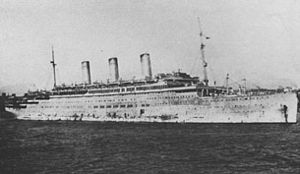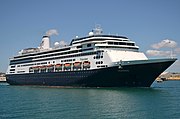SS Justicia
 Justicia painted grey for wartime service.
| |
| History | |
|---|---|
| Name |
|
| Owner |
|
| Operator | White Star Line |
| Builder | Harland and Wolff, Belfast |
| Yard number | 436 |
| Laid down | 1912 |
| Launched | 9 July 1914 |
| Completed | 7 April 1917[1] |
| In service | 1918 as a troopship |
| Renamed | Justicia |
| Fate | Sank after torpedoed six times on 19–20 July 1918. Four torpedoes were from UB-64, and two more torpedoes were from UB-124. |
| General characteristics | |
| Type | Steamship |
| Tonnage | 32,234 Gross register tons |
| Length | 776 ft (237 m) |
| Beam | 86 ft (26 m) |
| Propulsion | Triple expansion steam engines turning two outer propellers with an exhaust-steam turbine turning the centre propeller. |
| Speed | 18 kn (21 mph; 33 km/h) |
| Capacity | Intended passenger capacity of 3,430 people. |
| Troops | Approximately 4,000 |
SS Justicia was a British troopship sunk during the First World War. She was laid down as SS Statendam, a 32,234 gross-ton ocean liner built for the Holland America Line by Harland and Wolff in Belfast and launched on July 9, 1914. Shortly after, World War I broke out, and work slowed down. Eventually, before the ship was completed, negotiations between the British government and the company resulted in its acquisition by the former for use in the war effort.
It was at first planned to have it chartered by Cunard Line, which explained the renaming of the ship to Justicia to correspond to the nomenclature of the company. However, as the company did not have the necessary crews, the ship was eventually handed over to White Star Line, which was responsible for operating it as a troop transport. Her mission began in April 1917. After having escaped a first submarine attack in January 1918, she was torpedoed on July 19, 1918 off Skerryvore, and sank the next morning.
Although smaller in size than her direct competitors, the Statendam promised to be one of the most lavish ships in the North Atlantic route. Following the sinking, Holland America Line received significant compensation which allowed it to order a ship of the same name in 1921, which was not completed until 1929.
History[]
Construction and requisition[]
In 1912, Holland America Line, a Dutch company providing the transatlantic travel, ordered a new liner from the Harland and Wolff shipyards in Belfast. The ship was named Statendam, the second of the company's five ships to bear that name.[2] The liner was launched on July 9, 1914, and the completion of the ship began. However, the outbreak of World War I in the weeks that followed significantly slowed down the work.[3] On the other hand, the ship, already well advanced toward completion, offered great potential in the war.[4]
In October 1914, the British Admiralty offered the company £1,000,000 to operate the ship as it was, still unfinished, with the guarantee of returning it at the end of the conflict. The decorative elements already installed were removed and stored (in Rotterdam), as was customary in the context of the transformations of liners into troop transports.[5] The construction of the ship was proceeding slowly, applying special measures to the ship to adapt it to the war environment. Thus, the funnels were smaller than expected, in order to conserve steel.[6]
In 1915, the British government requisitioned Statendam for use as a troopship. The ship was at first given to the Cunard Line to manage as a compensation for the sinking of Lusitania in 1915, and the ship was renamed Justicia (Latin for justice) because of their traditional ship suffix -ia. Cunard had difficulty in assembling a crew for Justicia, so the ship was reassigned to the White Star Line, which had the crew of the sunken Britannic available.[2] However, the ship was not renamed again for comporting with the White Star Line's nomenclature of the suffix -ic.[4]
Military service and sinking[]

On April 7, 1917, the White Star Line took full possession of the Justicia, which left for her first crossings to Halifax, then between New York and Liverpool, in order to bring fresh troops to the front.[7] Her precise movements were, however, difficult to trace, as her activities were largely kept secret.[5] At the beginning of 1918, her grey hull was painted with dazzle camouflage developed by Norman Wilkinson. She was attacked soon after, on January 23, 1918, by a German submarine in the North Channel, but the torpedoes missed their target, and she escaped without damage.[8]
On 19 July 1918 Justicia sailed unladen under the command of John David from Belfast to New York escorted by destroyers.[9] While 23 miles south of Skerryvore, Scotland, she was torpedoed by the German Type III Coastal U-boat UB-64, under the command of Otto von Schrader. Justicia took on a list but the watertight doors were closed in time, temporarily preventing her from sinking. The U-64 fired two more torpedoes but they missed their target, one being destroyed by the Justicia's cannons. Shortly after, took the liner under tow in an attempt to beach the stricken ship at a suitable location near Lough Swilly. Tenacious, the submarine attempted a new attack, but the torpedo was again destroyed by the crew of the Justicia, part of which was evacuated before the towing continued.[10] A fourth torpedo struck the wounded Justicia but she still remained afloat. The escorts were able to damage UB-64, which departed the area, while radioing in Justicia's position.[1] The following day, UB-124 found Justicia and fired two more torpedoes just after 9:00 am, which struck her amidships. By noon the remaining crew had been evacuated and the vessel rolled onto her starboard side and sank. 16 crew members were killed. In total, Justicia had been hit by six torpedoes. The destroyers , , and Pigeon attacked with depth charges and sank UB-124 with gunfire after she surfaced.[11]
The German press was very enthusiastic about this sinking. Indeed, the Justicia, with its three funnels, resembled the SS Leviathan, a former German liner recovered by the Americans and used as a very large troop transport.[12] As for the Holland America Line, after the conflict, it received 60,000 tonnes of steel as compensation, which were used to build a fleet of freighters.[13] In 1921, the company ordered a new ship named Statendam, whose construction dragged on until 1929.[14]
The wreck of Justicia lies 28 mi (45 km) north-west of Malin Head, Ireland in waters 68 metres (223 ft) deep.[15]
Characteristics[]
With 236 m in length 26 m wide, and 32,234 GRT, the Statendam was designed as a medium-sized liner against its English and German competitors.[16] Its capacity was however very important, since the ship was planned for 800 passengers in first class, 600 in second and 2,030 in third, to which was added a crew of 600 people. The decoration of the ship was intended to be modern, close to the style adopted during the 1920s, with in particular a large first-class salon six meters high to be the largest room of this type on an ocean liner at the time.[17] As a troop transport, the Justicia has a capacity of 5,000 men, which was pushed to 12,000 men on one occasion. In addition, there were holds capable of transporting 15,000 tonnes of goods.[7]
The ship had three funnels, the last being a dummy intended to ensure the balance of the profile.[6] The propulsion of the ship followed a classic configuration of the creations of the Harland & Wolff shipyards popularized by the Olympic-class ships: using two reciprocating triple expansion machines and a low pressure turbine to power her propellers.[10] This allowed her to reach a speed of 18 knots, insufficient to guarantee her safety in military operations. She was therefore forced to sail while escorted in a convoy.[7]
References[]
- ^ Jump up to: a b "Homepage for the red duster merchant navy maritime information archive". Red-duster.co.uk. Retrieved 16 July 2009.
- ^ Jump up to: a b David Williams and Richard de Kerbrech 1982, p. 61
- ^ Buxton, Ian (2008) [1978]. Big Gun Monitors. Seaforth Publishing. pp. 17–21. ISBN 978-1-84415-719-8.
- ^ Jump up to: a b Richard de Kerbrech 2009, p. 175
- ^ Jump up to: a b John Eaton and Charles Haas 1989, p. 192
- ^ Jump up to: a b « Justicia of the White Star Line », Titanic-Titanic.com. Accessed 21 March 2013
- ^ Jump up to: a b c John Eaton and Charles Haas 1989, p. 194
- ^ David Williams and Richard de Kerbrech 1982, p. 63
- ^ "White Star Line Ships and the U-boats". Titanic-whitestarships.com. Retrieved 16 July 2009.
- ^ Jump up to: a b Richard de Kerbrech 2009, p. 176
- ^ John Eaton and Charles Haas 1989, p. 195
- ^ David Williams and Richard de Kerbrech 1982, p. 64
- ^ Richard de Kerbrech 2009, p. 177
- ^ David Williams and Richard de Kerbrech 1982, p. 66
- ^ « Statendam (II)/Justicia », The Great Ocean Liners
- ^ « Justicia, White Star Line », Norway Heritage
- ^ David Williams and Richard de Kerbrech 1982, p. 62
Bibliography[]
- de Kerbrech, Richard (2009). Ships of the White Star Line. Shepperton: Ian Allan Publishing. ISBN 978-0-7110-3366-5.
- Eaton, John; Haas, Charles (1989). Falling Star, Misadventures of White Star Line Ships. Patrick Stephens Ltd. ISBN 1-85260-084-5.
- Williams, David; de Kerbrech, Richard (1982). Damned by Destiny. Brighton: Teredo books. ISBN 0-903662-09-4. OCLC 10284842.
External links[]
| Wikimedia Commons has media related to Justicia (ship, 1917). |
- Ocean liners
- Troop ships of the United Kingdom
- Ships of the White Star Line
- Ships of the Holland America Line
- 1914 ships
- World War I shipwrecks in the Atlantic Ocean
- Maritime incidents in 1918
- Ships sunk by German submarines in World War I
- Ships built in Belfast
- Ships built by Harland and Wolff
